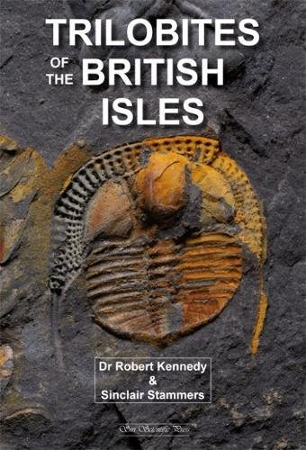Reviewed by Phil Novack-Gottshall (Benedictine University, Lisle, IL)

Kennedy, R. and S. Stammers. 2018. Trilobites of the British Isles. Siri Scientific Press, Rochdale, UK, 384 pp. (£37.50 at https://siriscientificpress.co.uk)
Ever since “Dudley’s locust” was popularized in the mid-eighteenth century (Mikulic and Kluessendorf, 2007), British and Irish trilobites have played an outsized role in inspiring paleontological interest and in establishing the Paleozoic timescale. An attractive and lavishly photographed new tome by Bob Kennedy and Sinclair Stammers manages to capture—in nearly 800 color plates—the spectacular diversity of trilobites from this region, their geological importance, and their major collecting locales, both modern and no-longer exposed. The volume builds on two other equally gorgeous trilobite monographs published recently by Siri Scientific Press, 2016’s Trilobites of the World (Pete Lawrence and Sinclair Stammers) and 2015’s Ordovician Trilobites of Southern Ontario, Canada and the Surrounding Region (Phillip Isotalo), both of which previously have been reviewed here in Priscum. Stammer was also the photographer for the global volume, and several of his photographs of British and Irish provenance are re-printed here.
By all accounts, the lead author, Robert Kennedy, is quite the corker. After myriad jobs led to an unfulfilling teaching position, his zeal for fossil collecting (especially trilobites) led him mid-life to formal graduate studies on Ordovician and later Devonian British trilobites, both published as Monographs of the Palaeontographical Association, London. Sinclair Stammer has worked as both a scientific and freelance photographer, recently specializing on microvideography.
The specimens contained in this volume represent the vast and important collections Kennedy has amassed throughout his lifetime, combined with historically important specimens (chiefly type specimens) located in museum collections. Many of the included specimens represent the most-complete specimens yet discovered, and many type specimens are also photographed herein for the first time. I estimate at least 80% of the included specimens were collected by Kennedy, and they surely represent only his choicest specimens. Although there are no repository numbers listed, it seems the specimens have been deposited in Birmingham’s Lapworth Museum, close to where Kennedy ended his professional (but not collecting) career as Principle Curator at the Birmingham Museum and Art Gallery.
The organization of the book will appeal to those interested in both an evolutionary compendium as well as those looking to collect their own specimens from well-known collecting locales. After a concise introduction to trilobites and the “founding fathers” of British trilobite research (Sedgwick, Murchison, and Lapworth), the remainder of the book is stratigraphically focused, with separate chapters on each trilobite-bearing Paleozoic period. Each chapter begins with the paleogeographic context, British stratigraphic series and outcrop maps, and their (often type) exposures. These chapters are further subdivided to discuss major fossil localities—often with recent and vintage photographs of the outcrops, nineteenth-century university fieldtrip entourages (much more respectably dressed but less safety-minded than my students) and relevant archival material such as Lapworth’s original, colored drawings). For those motivated to add to their own collections, Kennedy admirably provides hyperlinks for the government bodies that administer permissions to visit major sites. The stars of each section, of course, are the trilobites, nearly always of intact and well-prepared specimens, and often illustrating multiple specimens per species. (I could find no discussion of preparation methods, so presume Kennedy did the hard work himself.) My favorite archival photograph is that of Elizabeth Gray, of Girvan Starfish Beds fame, in 1922, just before her passing at 93 years old, rock hammer firmly in hand and ready to keep collecting with the same ardor she always possessed. (I also enjoyed that the 1840 Dudley Directory that lists three professional “fossil dealers” between fishmongers and fruiters in the alphabetical listing of trades.) Kennedy’s profiles of his many important trilobite-collecting forbears—men and women, amateur and professional—provides a welcome undertone throughout that emphasizes that our science, with its primal necessity for field exploration, is never exhausted and ever fruitful.
Despite the academic bonafides of the authors, this is not a monograph focused on scientific photographic standards. Although most specimens are oriented in conventional manner (anterior up, dorsal surface toward viewer), I could see no scale bars. (I confess, this is my perennial bugbear.) Each figure caption, however, does list the specimen length to the nearest millimeter. The photographs, always in full color, also lack ammonium chloride whitening, so anatomically diagnostic parts are not always apparent. Alas, a technical systematic intention is not the point here. The photographs are artfully done to enhance their appreciation by non-specialists and specialists alike, and the quality of the photographs is consistently very high.
Given the dozens of localities covered, it’s curious that the Index only cites species names. Given the comprehensive (and well referenced) text, it would have been fairly easy to produce a stand-alone Appendix featuring the faunal lists of known and photographed faunal lists for the covered localities and stratigraphic series. This is a minor gripe, as this information could be obtained by using the well detailed Table of Contents, and then perusing the relevant pages for a given age or place.
Some may gripe that the book is devoid of taxonomic information higher than genus names. I’m not one of these critics, given the ever-changing volatility in trilobite taxonomy in recent years, especially for ordinal and familial affinities. That information is too technical for most readers of this gorgeous book, and those requiring it can (mostly) easily obtain it elsewhere. The only error I noted—admittedly I’m more an admirer than specialist—was the mis-spelling of Exallaspis in their several excellent specimens from the Much Wenlock.
Clocking in at just over 1 kilogram, this is a small but mighty compendium of trilobite gorgeousness that will be appreciated by both specialist and avocational paleontologists.
Works cited
Mikulic, D. G., and J. Kluessendorf. 2007. Legacy of the locust: Dudley and its famous trilobite Calymene blumenbachii. Pp. 141-169. InD. G. Mikulic, E. Landing, and J. Kluessendorf, eds. Fabulous Fossils. 300 years of Worldwide Research on Trilobites. New York State Museum Bulletin New York State Museum, Albany, NY.

